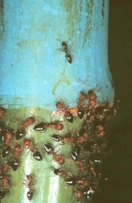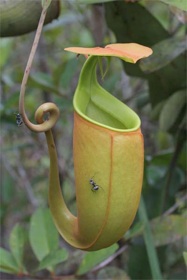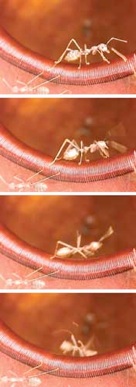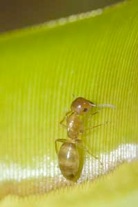Almost all land ecosystems have been shaped by interactions between insects and plants. While the chemical ecology of these relationships is widely studied, not much attention has been paid to biomechanical factors in insect-plant interactions. We investigate several interactions where mechanical factors play an important role, the foraging behaviour of leafcutter ants, as well as ant-plant interactions in the genera Macaranga and Nepenthes.
Macaranga ant-plants  Macaranga ant-plants provide food and living quarters inside their hollow stems for several species of specialised Crematogaster or Camponotus ants. In return, the ants work as an army of bodyguards against leaf-feeding insects and stem-borers. In many Macaranga ant-plants, the stem is covered by a bluish waxy layer. These surfaces consist of a carpet of microscopic wax crystals. As the crystals come off easily, the waxy stems are extremely slippery for insects. However, the ant partners of these trees are specialized "wax-runners". Thus, Macaranga wax barriers keep away most predators and competitors, but they create an enemy-free space for their ant partners (Federle et al. 1997, Federle & Bruening 2005).
Macaranga ant-plants provide food and living quarters inside their hollow stems for several species of specialised Crematogaster or Camponotus ants. In return, the ants work as an army of bodyguards against leaf-feeding insects and stem-borers. In many Macaranga ant-plants, the stem is covered by a bluish waxy layer. These surfaces consist of a carpet of microscopic wax crystals. As the crystals come off easily, the waxy stems are extremely slippery for insects. However, the ant partners of these trees are specialized "wax-runners". Thus, Macaranga wax barriers keep away most predators and competitors, but they create an enemy-free space for their ant partners (Federle et al. 1997, Federle & Bruening 2005).
Nephentes pitcher plants
 Pitcher plants of the genus Nepenthes have highly specialized leaves adapted to capture and digest arthropod prey.
Pitcher plants of the genus Nepenthes have highly specialized leaves adapted to capture and digest arthropod prey.
In most Nepenthes species, the critical structure responsible for insect trapping is the pitcher rim (peristome), which has a highly regular microstructure. Its surface is completely wettable so that it is covered by thin water films when wetted by condensation, rain or nectar. Only when wet, the peristome surface is slippery for insects, and most visitors "aquaplane" and fall into the pitcher
Insect aquaplaning!
 This weaver ant wanted to take a sip of the sweet pitcher nectar, which attracts unsuspecting visitors.
This weaver ant wanted to take a sip of the sweet pitcher nectar, which attracts unsuspecting visitors.
One Bornean pitcher plant species, Nepenthes bicalcarata, plays host to the very unusual ant Camponotus schmitzi that makes its nest in the hollow pitcher tendrils. Camponotus schmitzi ants are able to run around on the wet and slippery pitcher surfaces, where all other insects slip. They even descend into the pitcher fluid, where they dive and steal prey items!

Insect-plant interactions are studied by Jonathan Pattrick and Patrick Brechka.

